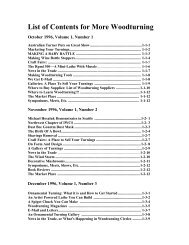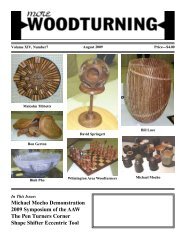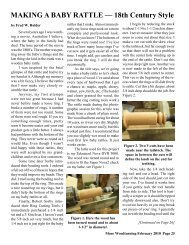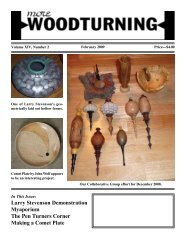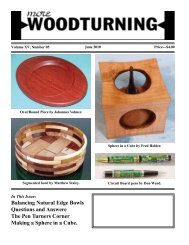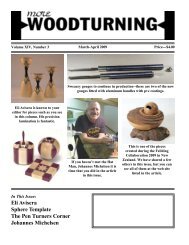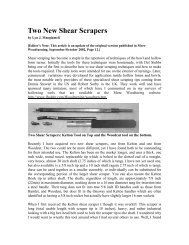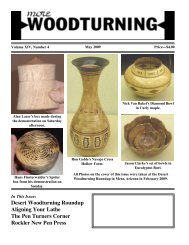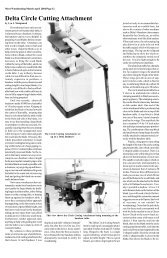Ranking Wear Resistance of Tool Steels for Woodturning - More ...
Ranking Wear Resistance of Tool Steels for Woodturning - More ...
Ranking Wear Resistance of Tool Steels for Woodturning - More ...
You also want an ePaper? Increase the reach of your titles
YUMPU automatically turns print PDFs into web optimized ePapers that Google loves.
<strong>Ranking</strong> <strong>Wear</strong> <strong>Resistance</strong> <strong>of</strong> <strong>Tool</strong> <strong>Steels</strong> <strong>for</strong> <strong>Woodturning</strong><br />
James T. Staley, Adjunct Pr<strong>of</strong>. in the Dept. <strong>of</strong> Materials Science and Engineering at North Carolina State<br />
University, Raleigh<br />
Woodturners have seen tool makers’ ads claiming that their tools last 3X to 10X longer<br />
than M2, the most widely used tool steel <strong>for</strong> wood turning. None <strong>of</strong> these claims are<br />
accompanied with data. I am a metallurgical engineer as well as a woodturner, who<br />
much prefers turning to sharpening. Consequently, I proposed to Crucible Materials that<br />
they sponsor a relevant Senior Project in the Materials Science and Engineering Dept. <strong>of</strong><br />
N.C. State U. in Raleigh. The objective was to rank the wear resistance <strong>of</strong> steels used in<br />
woodturning relative to M2 and to develop a metallurgical explanation <strong>for</strong> the results.<br />
Emeritus Pr<strong>of</strong>. Hans Conrad agreed to be co-advisor to the team <strong>of</strong> Matt Rothwell,<br />
Marshall Jones, Will Milan, and Steve Starnes.<br />
When we contacted tool manufacturers <strong>for</strong> the test procedures that they used to support<br />
their claims, we received no response. The methods that Crucible Materials and other<br />
steel manufacturers per<strong>for</strong>m to rank wear resistance do not involve cutting any wood.<br />
<strong>More</strong>over, we found that different steel companies ranked wear resistance <strong>of</strong> the same<br />
steels in different orders. Consequently, we developed our own evaluation procedures.<br />
We wanted a test method that would apply the tool to the wood at a constant angle and<br />
feed rate to eliminate the influence <strong>of</strong> the operator. We also wanted to obtain test data<br />
that would be quantitative. We chose Ring Master®, a hobbyist tool that is available<br />
either as a stand-alone or as an accessory <strong>for</strong> many lathe models, Fig. 1. Ring Master®<br />
cuts with twin 1/16” wide blades that are akin to a narrow scraper, Fig.2. Porta-Nails<br />
Inc., the manufacturer donated the use <strong>of</strong> two units. We used one to prepare test discs.<br />
We equipped the other with a computer controlled DC motor that rotated at 6 rpm to<br />
drive the 13 threads per inch screw that advanced the blades.
Figure 1. Ring Master® is a hobbyist tool that cuts rings that are glued together to make<br />
vessels.<br />
Figure 2. Ring Master® uses two 1/16” x 3/18” blades as cutting tools.<br />
For steels, we used those that steel companies donated, Table 1. T15 is used <strong>for</strong> Ring<br />
Master® blades. 10V is also known as A11 and is used in premium woodturning tools.<br />
15 V has higher vanadium. Crucible Materials recently developed Rex86 <strong>for</strong> improved<br />
wear resistance. All were supplied in the fully heat treated, triple tempered condition.<br />
Porta-Nails, Inc. ground the 3/16” square steel rod to sharpened blades ready <strong>for</strong> test.<br />
In addition, we evaluated effects <strong>of</strong> cryotreatment on M2 and 10V. Cryotreatment was<br />
per<strong>for</strong>med by a commercial heat treatment shop that specializes in cryotreatment below -<br />
300 F. They per<strong>for</strong>med the treatment on triple tempered blades.
Steel C Mn Si Cr V W Mo Co<br />
M2 1,3 0.85 0.3 0.3 4.2 1.9 6.0 5.00 0<br />
T15 1,4 1.60 0.3 0.3 4.3 5.0 12.0 0.80 5.0<br />
Rex86 2,4 2.0 0 0 4.0 5.0 10.0 5.0 9.0<br />
10V 2,4 2.45 0.5 0.9 5.3 9.8 0 1.3 0<br />
15V 2,4 3.4 0.5 0.9 5.3 15.0 0 1.3 0<br />
1 donated by Latrobe Steel<br />
2 donated by Crucible Materials<br />
3 4 made by conventional ingot metallurgy made by powder metallurgy<br />
Table 1, <strong>Steels</strong> used <strong>for</strong> test program<br />
For wood, we chose both hard, purple heart, and s<strong>of</strong>t, poplar, woods that are used by<br />
woodturners. We dropped the poplar early in the investigation because it took so long to<br />
wear even the M2.<br />
Test Procedure<br />
To per<strong>for</strong>m a test, the students mounted an 11.5” x diameter disc on the Ring Master(R),<br />
Fig. 3. They adjusted the tool carriage so that the blades would enter at 5 1.2” radius and<br />
rotated the disc at 800 rpm. The computer program automatically controlled the motor to<br />
feed one <strong>of</strong> the blades into the disc at a rate <strong>of</strong> about ½” in./min. until it had cut half<br />
through the 13/16” thickness. Then it reversed the direction <strong>of</strong> the motor to withdraw the<br />
blade and feed the blade from the other side to complete the through-cut. After the cut,<br />
they removed the ring that was separated from the disc and advanced the blade about<br />
3/8”. The students repeated the process until they had made 12 cuts, Fig 4 Wood<br />
removal rate was about 1 in. 3 /min. <strong>for</strong> the 1 st cut and about ½ in. 3 /min. <strong>for</strong> the 12 th cut.<br />
For each steel, they cut 3 disks <strong>for</strong> a total <strong>of</strong> 36 cuts per steel blade. The operation<br />
removed a total volume <strong>of</strong> over 25 cubic inches. Table 2 presents equivalent volumes <strong>of</strong><br />
wood removed during spindle and bowl turning.<br />
Hemispherical Bowl 4” diameter x 6 “ spindle<br />
1 st disc 3” inside diameter 3 ½” diameter<br />
2 nd disc 4” inside diameter 3 3/32” diameter<br />
3 rd disc 4 1/16” inside diameter 2 5/8” diameter<br />
Table 2 Shows equivalent volume <strong>of</strong> wood turned from typical shapes
Figure 3. Experimental set-up <strong>for</strong> 1 st cut. Blades were moved manually towards the<br />
center after each through-cut.<br />
Figure 4. Discs be<strong>for</strong>e and after cutting
Evaluation<br />
As a tool wears, more <strong>for</strong>ce must be applied to enter the wood at a constant rate because<br />
<strong>of</strong> the increased friction. Current on a constant voltage motor is directly proportional to<br />
<strong>for</strong>ce. Consequently, the students recorded the current, and we used it as a quantitative<br />
measure <strong>of</strong> tool wear.<br />
Weight loss <strong>of</strong> a tool is a standard method <strong>of</strong> measuring wear. Our ef<strong>for</strong>ts to do this were<br />
frustrated because <strong>of</strong> a tenacious film <strong>of</strong> resin that exuded from the purpleheart and<br />
coated the blades. Even the most worn blade weighed more after the test than be<strong>for</strong>e.<br />
The far corner <strong>of</strong> each blade wore preferentially because <strong>of</strong> the test set-up. The students<br />
measured the diameter <strong>of</strong> curvature <strong>of</strong> the worn corner using a scanning electron<br />
microscope. We used the square <strong>of</strong> either the diameter or the radius as a quantitative<br />
measure <strong>of</strong> wear because those values are proportional to the volume <strong>of</strong> steel worn away..<br />
Results<br />
We plotted average current per cut (proportional to <strong>for</strong>ce) versus volume <strong>of</strong> wood<br />
removed <strong>for</strong> each steel. Current while cutting with M2 blades began to increase<br />
immediately, Fig 5. Current <strong>for</strong> the other steels took longer be<strong>for</strong>e it began to increase,<br />
Fig. 6. We decided that the most useful way to interpret the vast quantity <strong>of</strong> data was to<br />
use the average <strong>of</strong> the current over the entire 72 cuts (12 cuts per side on 3 discs). The<br />
steels are arranged in order <strong>of</strong> increasing wear resistance as indicated by average current<br />
in Fig. 7. Effects <strong>of</strong> cryotreatment were mixed and not extensive. Current <strong>of</strong> cryotreated<br />
M2 was higher than that <strong>of</strong> untreated M2 while current <strong>of</strong> cryotreated 10V was lower.<br />
This suggests that cryotreatment had no effect.<br />
Figure 5. M2 blades began to wear immediately as indicated by increase in current to<br />
keep blade entering the wood at a constant rate. Cryotreated M2 behaved similarly. The<br />
students reported that both M2 and cryotreated M2 blades caused the wood to smoke<br />
during the final cuts on the 3 rd disc.
Figure 6. <strong>Wear</strong> didn’t begin appreciably on 15V until the 3 rd disk was cut. Rex86<br />
behaved similarly. The other steels per<strong>for</strong>med intermediate to that <strong>of</strong> M2 and 15V.<br />
250<br />
Averaje current, mA<br />
240<br />
230<br />
220<br />
210<br />
200<br />
M2<br />
cryo<br />
M2 10 V 10 V<br />
cryo<br />
T 15 15 V Rex 86<br />
Figure 7. <strong>Steels</strong> are ranked according to current averaged over the entire 72 cuts. Low<br />
current indicates less <strong>for</strong>ce required to keep the blade entering the wood at a constant rate<br />
and, hence, higher resistance to wear.<br />
The worn corner <strong>of</strong> one blade <strong>of</strong> each steel are depicted in Fig. 8. Volume <strong>of</strong> metal worn<br />
away is proportional to the square <strong>of</strong> either the radius or diameter <strong>of</strong> curvature <strong>of</strong> the<br />
worn corner, so we used those values to interpret the data. The results are summarized in<br />
the bar graph in Fig 9. In this case, the cryotreated versions <strong>of</strong> M2 and 10V were slightly<br />
more worn than their untreated counterparts. This confirms that cryotreatment had no<br />
effect on resistance to wear.
Plots <strong>of</strong> average current vs. the square <strong>of</strong> the radius <strong>of</strong> the worn corner showed that<br />
average current and corner wear were linearly proportional, Fig. 10.<br />
Figure 8. Illustrates worn corner <strong>of</strong> each steel. Measurements <strong>of</strong> the radius <strong>of</strong> curvature<br />
<strong>of</strong> the corner are indicated.<br />
Corner radius squared, sq. microns<br />
6000<br />
5000<br />
4000<br />
3000<br />
2000<br />
1000<br />
0<br />
M2<br />
cryo<br />
M2<br />
10 V<br />
Cryo<br />
10 V T 15 15 V Rex<br />
86<br />
Figure 9. <strong>Steels</strong> arranged in increasing resistance to corner wear
Figure 10. Corner wear as measured by the square <strong>of</strong> the radius <strong>of</strong> the worn corner and<br />
average <strong>for</strong>ce during cutting as measured by average current are linearly related<br />
Metallurgical interpretation <strong>of</strong> results<br />
The principle metallurgical differences in the steels were volume fraction <strong>of</strong> carbides and<br />
hardness. Consequently, the students measured the Rockwell C hardness and determined<br />
the volume fraction <strong>of</strong> carbides, Figs. 11a and b illustrates the carbides in the steels with<br />
the lowest, M2, and highest, 15V, volume fractions <strong>of</strong> carbides. The figure also<br />
illustrates the effects <strong>of</strong> powder metallurgy processing. The carbides in 15V are finer and<br />
more uni<strong>for</strong>m in size.<br />
Figure 11a. Volume fraction, fc, <strong>of</strong> M2 was 0.099. Note the mixture <strong>of</strong> coarse and fine<br />
carbide particles.
Figure 11b. Volume fraction, fc, was 0.224. Note the finer and more homogeneously<br />
distributed carbides compared to M2.<br />
Volume fraction, fc, and hardness <strong>of</strong> all steels are presented in Table 3 We converted<br />
Rockwell C hardness to Vickers hardness, Hv because Hv is a more fundamental<br />
property.<br />
Steek Volume fraction<br />
carbides, fc<br />
Rockwell hardness,<br />
C scale<br />
Vickers hardness,<br />
Hv, Kg/mm 2<br />
M2 0.099 64.0 800<br />
T15 0.185 64.9 829<br />
Rex86 0.172 67.5 920<br />
10V 0.135 60.5 709<br />
15V 0.224 60.9 718<br />
M2 cryo 0.099 63.3 780<br />
10V cryo 0.135 60.6 711<br />
Table 4. Metallurgical parameters<br />
Pr<strong>of</strong>essor Conrad developed a theory <strong>of</strong> wear that predicts that resistance to wear will<br />
increase as the product <strong>of</strong> Vickers hardness, Hv, and the ratio <strong>of</strong> the volume fraction <strong>of</strong><br />
carbides to the volume fraction <strong>of</strong> the steel matrix, fc/(1-fc), increases. The plot <strong>of</strong> the<br />
square <strong>of</strong> the corner diameter, D 2 vs. Hv * fc/(1-fc) in Fig. 12 shows that this measure <strong>of</strong><br />
wear decreased linearly as this product increased. Similarly, average current during<br />
turning the 3 discs, I, decreased linearly with increasing values <strong>of</strong> Hv * fc/(1-fc), Fig. 13.<br />
Normalizing the results by dividing all data by the data <strong>for</strong> M2 provides the relative merit<br />
<strong>of</strong> each steel, Fig. 14. The bar graph in Fig. 15 illustrates the ranking.<br />
Because cryotreatment has no effect on carbides and negligible effect <strong>of</strong> hardness <strong>of</strong><br />
triple tempered steel, per<strong>for</strong>mance is predicted to be the same as that <strong>of</strong> untreated<br />
material. The lack <strong>of</strong> effect <strong>of</strong> cryotreatment is not surprising when one considers the<br />
metallurgical changes during heat treatment described in the Appendix.
The relatively low advantage <strong>of</strong> the highly touted 10V steel was unexpected. It contains<br />
a large amount <strong>of</strong> vanadium which <strong>for</strong>ms vanadium carbides, the hardest carbides in tool<br />
steels. Despite this difference, our wear equation is insensitive to the type <strong>of</strong> carbide.<br />
We believe that the reason <strong>for</strong> the insensitivity to carbide type is because all carbides are<br />
so much harder than even the hardest wood that it doesn’t matter <strong>for</strong> woodturning.<br />
Figure 12. <strong>Resistance</strong> to corner wear, as measured by the square <strong>of</strong> the diameter <strong>of</strong><br />
curvature if the worn corner, increased linearly as the product <strong>of</strong> Vickers hardness, and<br />
the ratio <strong>of</strong> the volume fraction <strong>of</strong> carbides to the volume fraction <strong>of</strong> steel matrix<br />
increased.<br />
Figure 13. <strong>Resistance</strong> to wear, as measured by the average current, also increased<br />
linearly as the product <strong>of</strong> Vickers hardness and the ratio <strong>of</strong> the volume fraction <strong>of</strong><br />
carbides to the volume fraction <strong>of</strong> steel matrix increased.
Figure 14. Normalizing the data with respect to M2 provides a way to rank the steels<br />
relative to that baseline material.<br />
Relative wear<br />
2.5<br />
2<br />
1.5<br />
1<br />
0.5<br />
0<br />
M2 10 V T15 Rex 86 15 V<br />
Figure 15. <strong>Wear</strong> resistance <strong>of</strong> tested tool steels relative to M2 based on Hv * fc/(1-fc).<br />
Predicting per<strong>for</strong>mance <strong>of</strong> other tool steels<br />
Armed with the knowledge <strong>of</strong> the linearly relationship between the resistance to wear<br />
and Hv * fc/(1-fc), we can predict the relative per<strong>for</strong>mance <strong>of</strong> other tool steels if we<br />
know their hardness and volume fraction <strong>of</strong> carbides. We contacted several tool<br />
manufacturers who directed us to their steel suppliers <strong>for</strong> the data. The results are<br />
summarized in the bar graph in Fig. 16. All are predicted to out per<strong>for</strong>m M2. None<br />
attained the amount <strong>of</strong> advantage presented in the tool makers literature.
Predicted relative wear<br />
2.5<br />
2<br />
1.5<br />
1<br />
0.5<br />
0<br />
M2<br />
M4<br />
10 V<br />
ASP30<br />
ProPm<br />
T15<br />
Rex 86<br />
15 V<br />
ASP60<br />
Figure 16. Predicted relative wear resistance <strong>of</strong> tool steels when turning hard, dry wood<br />
Conclusions<br />
Relative wear resistance <strong>of</strong> tool steels when turning hard, dry wood rank similarly using<br />
either measurements <strong>of</strong> corner wear or average current <strong>of</strong> a motor driving the tool into the<br />
wood at a constant rate.<br />
These measures <strong>of</strong> resistance to wear increase linearly as the product <strong>of</strong> Vickers hardness<br />
and the ratio <strong>of</strong> the volume fraction <strong>of</strong> carbides to volume fraction <strong>of</strong> the steel matrix<br />
increases.<br />
Using this criterion, wear resistance <strong>of</strong> any tool steel can be calculated if these values are<br />
known.<br />
All <strong>of</strong> the steels advertised as being more wear resistant than M2 are truly more resistant.<br />
However, the relative wear resistance is less than claimed.<br />
Cryotreatment applied to triple tempered tool steel has no effect on wear resistance.<br />
Appendix<br />
Simplified description <strong>of</strong> heat treatment <strong>of</strong> tool steels.<br />
Be<strong>for</strong>e heat treatment, the structure is a s<strong>of</strong>t matrix <strong>of</strong> essentially pure iron and<br />
alternating platelets <strong>of</strong> carbide and pure iron called pearlite. The initial high temperature<br />
treatment dissolves the carbide platelets. The matrix structure <strong>for</strong>med at the high<br />
temperature contains carbon and alloying elements. And is referred to as Austenite. The<br />
carbon and alloying elements that didn’t dissolve at the initial high temperature is in the<br />
<strong>for</strong>m <strong>of</strong> carbides consisting mainly <strong>of</strong> W, Mo, and V. These are the carbides that are in<br />
the term fc. When this structure is quenched, most <strong>of</strong> the austenite trans<strong>for</strong>ms to a hard<br />
brittle Martensitic structure which traps the carbon. To make the material useful, it must<br />
be tempered at an intermediate temperature. This produces the structure known as<br />
tempered Martensite. When highly alloyed steels such as tool steels are quenched not all
<strong>of</strong> the Austenite trans<strong>for</strong>ms to Martensite. Cooling to temperatures near -300 F,<br />
trans<strong>for</strong>ms the retained Austenite to Martensite. <strong>Tool</strong> steels, however, are triple<br />
tempered. One <strong>of</strong> the effects <strong>of</strong> triple tempering is to trans<strong>for</strong>m the retained Austenite to<br />
Martensite. Consequently, we anticipate that cryotreatments <strong>of</strong> tool steels, regardless <strong>of</strong><br />
when the treatment is applied will have the same structure and properties <strong>of</strong> triple<br />
tempered tool steels.



